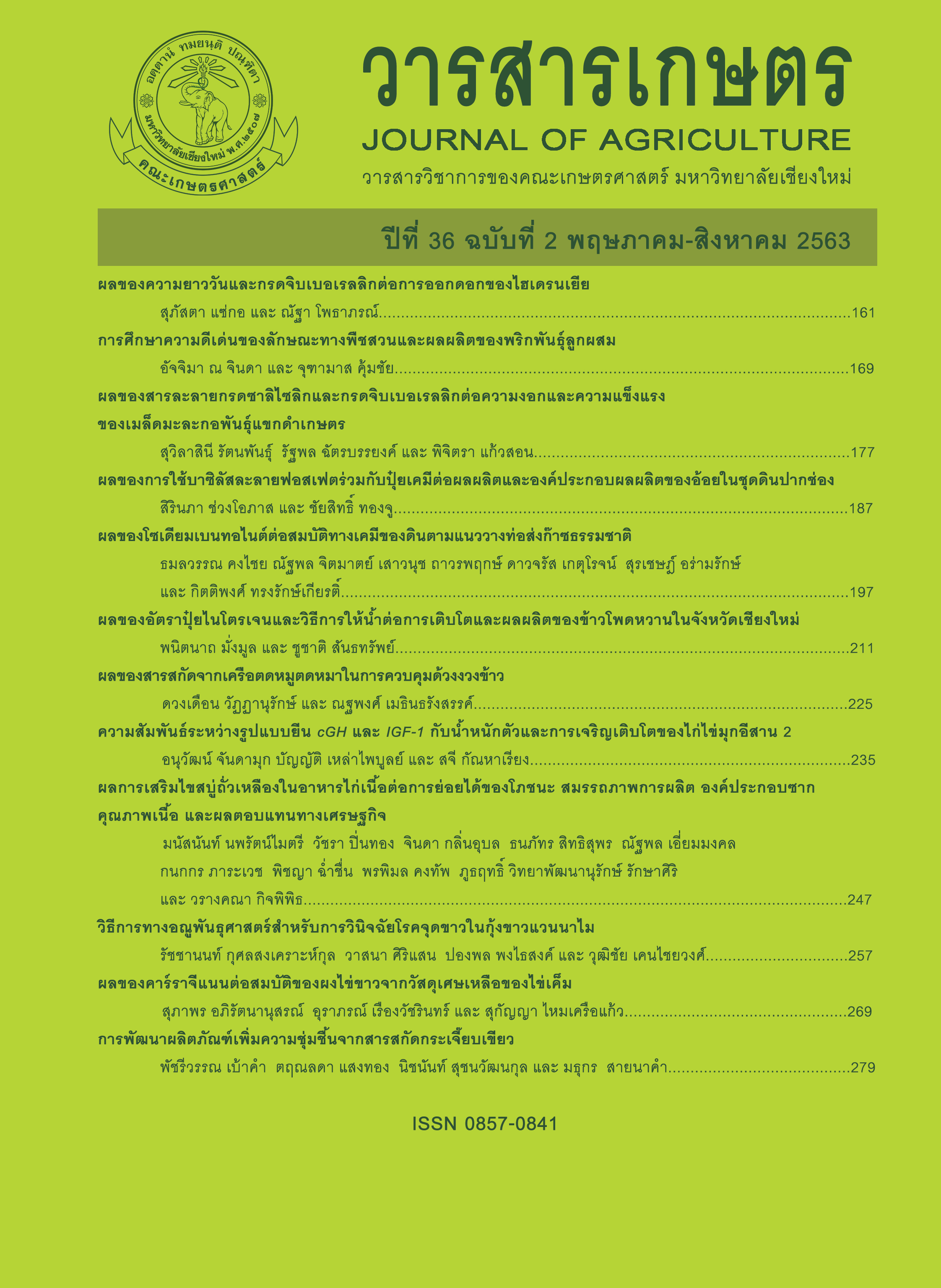การพัฒนาผลิตภัณฑ์เพิ่มความชุ่มชื้นจากสารสกัดกระเจี๊ยบเขียว
Main Article Content
บทคัดย่อ
งานวิจัยนี้มีวัตถุประสงค์เพื่อสกัดและทดสอบฤทธิ์ทางชีวภาพของสารสกัดฝักกระเจี๊ยบเขียว เพื่อพัฒนาเป็นผลิตภัณฑ์เพิ่มความชุ่มชื้น การศึกษานี้ได้นำฝักกระเจี๊ยบเขียวมาสกัดด้วยน้ำ และเอทานอลความเข้มข้นต่าง ๆ ด้วยวิธีแช่หมักโดยไม่ใช้ความร้อน (Maceration; MT) และวิธีไหลย้อนกลับด้วยความร้อน (Reflux; RF) จากนั้นนำสารสกัดหยาบมาทดสอบหาปริมาณพอลิแซ็กคาไรด์และสารฟีนอลิกรวม ทดสอบฤทธิ์การกำจัดอนุมูลอิสระและความสามารถในการยับยั้งปฏิกิริยาออกซิเดชันของไขมัน ตั้งตำรับผลิตภัณฑ์อิมัลชันเจลที่มีส่วนผสมของสารสกัดฝักกระเจี๊ยบเขียวเพื่อประเมินความคงตัวของตำรับ ทดสอบการระคายเคืองด้วยวิธี patch test และความชุ่มชื้นในผิวหนังของอาสาสมัครเพศหญิงผลการทดลองพบว่าสารสกัดฝักกระเจี๊ยบเขียวแห้งที่สกัดด้วยเอทานอลความเข้มข้น 50% โดยวิธี MT (MTD) มีเปอร์เซ็นต์ผลที่ได้ (% yield) เท่ากับ 27.50% มีปริมาณสารสำคัญและฤทธิ์ทางชีวภาพเหมาะสม โดยมีปริมาณพอลิแซ็กคาไรด์ 5.58±0.03 mg glucose/g ปริมาณฟีนอลิกรวม 1.24±0.01 mg GAE/g มีค่าความเข้มข้นของสารที่กำจัดอนุมูลอิสระ DPPH ได้ร้อยละ 50 (SC50) เท่ากับ 0.59±0.07 mg/ml และค่าความเข้มข้นของสารที่สามารถยับยั้งปฏิกิริยาออกซิเดชันของไขมันได้ร้อยละ 50 (IPC50) เท่ากับ 0.02±0.02 mg/ml สารสกัด MTD ถูกนำมาเตรียมตำรับผลิตภัณฑ์อิมัลชันเจลที่มีความคงตัว ไม่ก่อให้เกิดการระคายเคือง และเพิ่มความชุ่มชื้นให้แก่ผิวหนังของอาสาสมัครหลังทาผลิตภัณฑ์เป็นระยะเวลาถึง 90 นาที ดังนั้นผลิตภัณฑ์เครื่องสำอางที่มีส่วนผสมของสารสกัดฝักกระเจี๊ยบเขียวจึงมีศักยภาพในการนำมาพัฒนาเป็นผลิตภัณฑ์เพิ่มความชุ่มชื้นให้แก่ผิวหนัง
Article Details
เอกสารอ้างอิง
Chansukh, K. 2019. Isolation, separation and identification of active principles from medicinal plants. (Online). Available: elfit.ssru.ac.th/kittsak_ja/pluginfile.php/98/block_html/content/4-Isolation Separation and identification of active principles from medicinal plants-kitthisak.pdf (October 21, 2019). (in Thai)
Chen, Y., M.F. Wang, R.T. Rosen and C.T. Ho. 1999. 2,2-diphenyl-1-picrylhydrazyl radical scavenging active components from Polygonum multiforum Thumb. Journal of Agricultural and Food Chemistry 47(6): 2226-2228.
di Nardo, A., K. Sugino, P. Wertz, J. Ademola and H.I. Maibach. 1996. Sodium lauryl sulfate (SLS) induced irritant contact dermatitis: a correlation study between ceramides and in vivo parameters of irritation. Contact Dermatitis 35(2): 86-91.
Fan, S., Y. Zhang, Q. Sun, L. Yu, M. Li, B. Zheng, X. Wu, B. Yang, Y. Li and C. Huang. 2014. Extract of okra lowers blood glucose and serum lipids in high-fat diet-induced obese C57BL/6 mice. Journal of Nutritional Biochemistry 25(7): 702-709.
Gülçin, I. 2006. Antioxidant activity of caffeic acid (3, 4-dihydroxycinnamic acid). Toxicology 217(2-3): 213-220.
Huang, C.K. and T.A. Miller. 2007. The truth about over-the-counter topical anti-aging products: A comprehensive review. Aesthetic Surgery Journal 27(4): 402-412.
Huda-Faujan, N., Z.A. Rahim, M.M. Rehan and F.B.H. Ahmad. 2015. Comparative analysis of phenolic content and antioxidative activities of eight Malaysian traditional vegetables. Malaysian Journal of Analytical Sciences 19(3): 611-624.
Jaipakdee, N., K. Trakanchaiwong and E. Limpongsa. 2015. Evaluation of physical stability, efficacy and preference of anticellulite cream containing natural compounds. Isan Journal of Pharmaceutical Sciences 11(2): 55-70. (in Thai)
Jia, G.T. and H.Q. Zhao. 2015. Extraction and Antioxidant Activity of Polysaccharide from Salvia miltiorrhiza. pp. 106-109. In: Proceedings of International Conference on Chemical, Material and Food Engineering. Atlantis Press, Paris.
Jia, L., H.F. Li and L.L. Jing 2011. Chemical constituents in n-butanol extract of Abelmoschus esculentus L. Chinese Traditional and Herbal Drugs 41(11): 1771-1773.
Knight, J.A. and R.P. Voorhees. 1990. Peroxidation of linolenic acid—catalysis by transition metal ions. Annals of Clinical and Laboratory Science 20(5): 347-352.
Kanlayavattanakul, M., C. Rodchuea and N. Lourith. 2012. Moisturizing effect of alcohol-based hand rub containing okra polysaccharide. International Journal of Cosmetic Science 34(3): 280-283.
Limpongsa, E., N. Jaipakdee and S. Deeseenthum. 2014. Formulation and evaluation of facial masks prepared from Thai jasmine rice. KKU Research Journal 19(6): 905- 915. (in Thai)
Manosroi, A., P. Jantrawat, M. Sainakham, W. Manosroi and J. Manosroi. 2012. Anticancer activities of the extract from Longkong (Lansium domesticum) young fruits. Pharmaceutical Biology 50(11): 1397-1407.
Manosroi, A., M. Sainakham, C. Chankhampan, W. Manosroi and J. Manosroi. 2016. In vitro anti-cancer of Job’s tears (Coix lachryma-jobi Linn.) extracts on human colon adenocarcinoma. Saudi Journal of Biological Sciences 23(2): 248-256.
Roy, A., S.L. Shrivastava and S.M. Mandal. 2014. Functional properties of okra Abelmoschus esculentus L. (Moench): traditional claims and scientific evidences. Plant Science Today 1(3): 121-130.
Visioli, F. and C. Galli. 1998. The effect of minor constituent of olive oil on cardiovascular disease: new findings. Nutrition Reviews. 56(5): 142-147.
Yuan, Q., S. Lin, Y. Fu, X.R. Nie, W. Liu, Y. Su, Q.H. Han, L. Zhao, Q. Zhang, D.R. Lin, W. Qin and D.T. Wu. 2019. Effects of extraction methods on the physicochemical characteristics and biological activities of polysaccharides from okra (Abelmoschus esculentus). International Journal of Biological Macromolecules 127: 178-186.
Zhang, Q., J. Zhang, J. Shen, A. Silva, D.A. Dennis and C.J. Barrow. 2006. A simple 96-well microplate method for estimation of total polyphenol content in seaweeds. Journal of Applied Phycology 18(3-5): 445-450.
Zou, P., X. Yang, W.W. Huang, H.T. Zhao, J. Wang, R.B. Xu, X.L. Hu, S.Y. Shen and D. Qin. 2013. Characterization and bioactivity of polysaccharides obtained from pine cones of Pinus koraiensis by graded ethanol precipitation. Molecules 18(8): 9933-9948.


